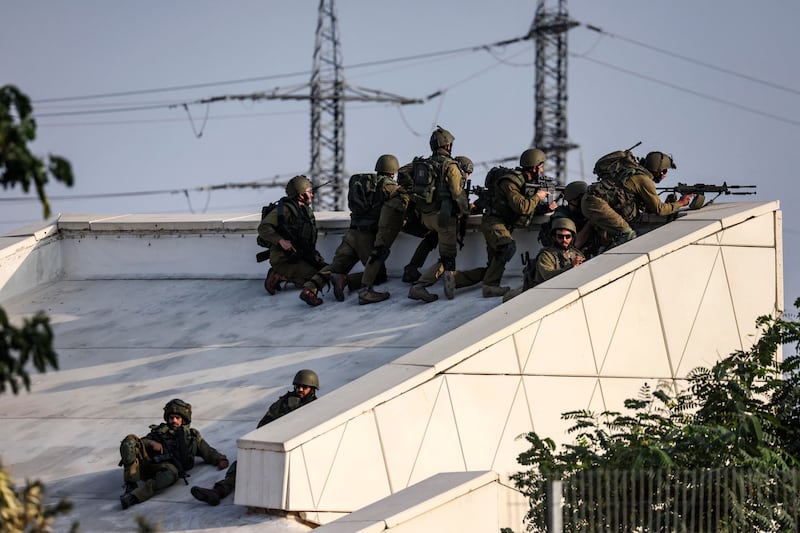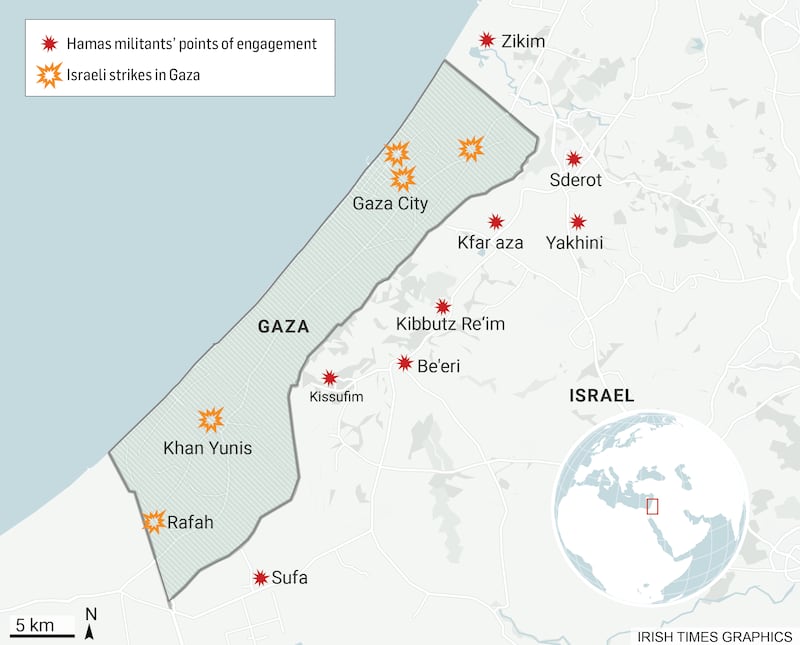There is not a family in Israel who doesn’t know, directly or indirectly, someone who was killed or wounded in Saturday’s surprise attack by Hamas militants across the Gaza border. Most families also know one of the more than 100 civilians and soldiers who were seized, dead or alive, by the infiltrators and are now being held by militants in Gaza.
By Sunday afternoon there was also not a single Israeli family who didn’t know someone who had received an emergency call-up and had reported to their army or air force reserve unit, ready to participate in the military attack on Gaza, which promises to be on a scale far, far bigger than anything seen before.
As the official death count on the Israeli side topped 700 – the majority believed to be civilians from Gaza border communities – the sheer magnitude of Saturday’s attack began to sink in, but was still difficult to grasp. Even for a country used to wars and waves of terror attacks, 700 fatalities in a single day was almost impossible to digest.
For the past month the country has been busy marking the 50th anniversary of the outbreak of the 1973 Yom Kippur war when the armies of Egypt and Syria invaded in a well-orchestrated surprise attack which, in the initial stages of the conflict, threatened Israel’s very existence. It was the country’s biggest intelligence failure.
RM Block
For many commentators, Saturday’s attack (50 years and one day after the start of the 1973 war) was worse. The colossal intelligence failure was repeated but even though Hamas cannot threaten Israel’s existence, the fact that a militant group – and not standing armies with thousands of tanks and planes – can inflict such damage on a regional superpower is a stinging humiliation that will never be forgotten.

The looming military operation aims to topple the Hamas regime in Gaza, eliminate the political and military leadership of the militant group, along with the smaller and even more radical Islamic Jihad, and destroy the entire militant infrastructure and underground tunnel network.
Mass bombing of targets is already under way – “softening up” in military parlance – ahead of the ground incursion. This time Israel will not settle for a brief occupation of a few neighbourhoods: the target is the coastal enclave in its entirety.
The full might of Israel’s military will be unleashed. The cost will be enormous, with civilians in the densely populated cities and refugee camps likely to suffer the most – “collateral damage” in military parlance.
The fate of the more than 100 Israelis seized by militants on Saturday and taken to Gaza also hangs in the balance.

[ Timeline: Israel's conflicts in the Middle EastOpens in new window ]
[ Irish woman missing after Hamas attack on rave in IsraelOpens in new window ]
Israel withdrew from Gaza in 2005, dismantling 21 Jewish settlements. For most Israelis the Gaza disengagement, ordered by former general-turned prime minister Ariel Sharon, was a huge relief. However, the ensuing years have proved that Israel can leave Gaza but Gaza won’t leave Israel. Hamas came to power, replacing Fatah, Israel imposed a blockade and cross-border clashes have grown in frequency and intensity.
Israel will defeat Hamas and the Islamic Jihad, even at a painful cost, but there is no credible exit strategy. Israel doesn’t want to resume responsibility for more than two million impoverished, hostile residents. But revenge is in the air and difficult questions are being brushed aside.
However, even a crushing Israeli military victory will not be enough to wipe out the profound impact of the attack by militant groups during Saturday’s lightning strikes across southern Israel.
Ostensibly, Hamas claimed Saturday’s attack was in response to Israeli actions against the al-Aqsa compound, or Noble Sanctuary in Jerusalem’s old city, revered by Jews as the Temple Mount. Thousands of religious Jews had visited the site, holy to Muslims and Jews, in recent weeks, despite Hamas warnings.
But Iran, which provides arms and money to Hamas and the Islamic Jihad, will be hoping that a bloody conflict will turn the Arab and Muslim world against Israel and derail moves for normalisation between Israel and Saudi Arabia, a worrying development from Tehran’s viewpoint, as it could go a long way to ending Israel’s regional isolation.













